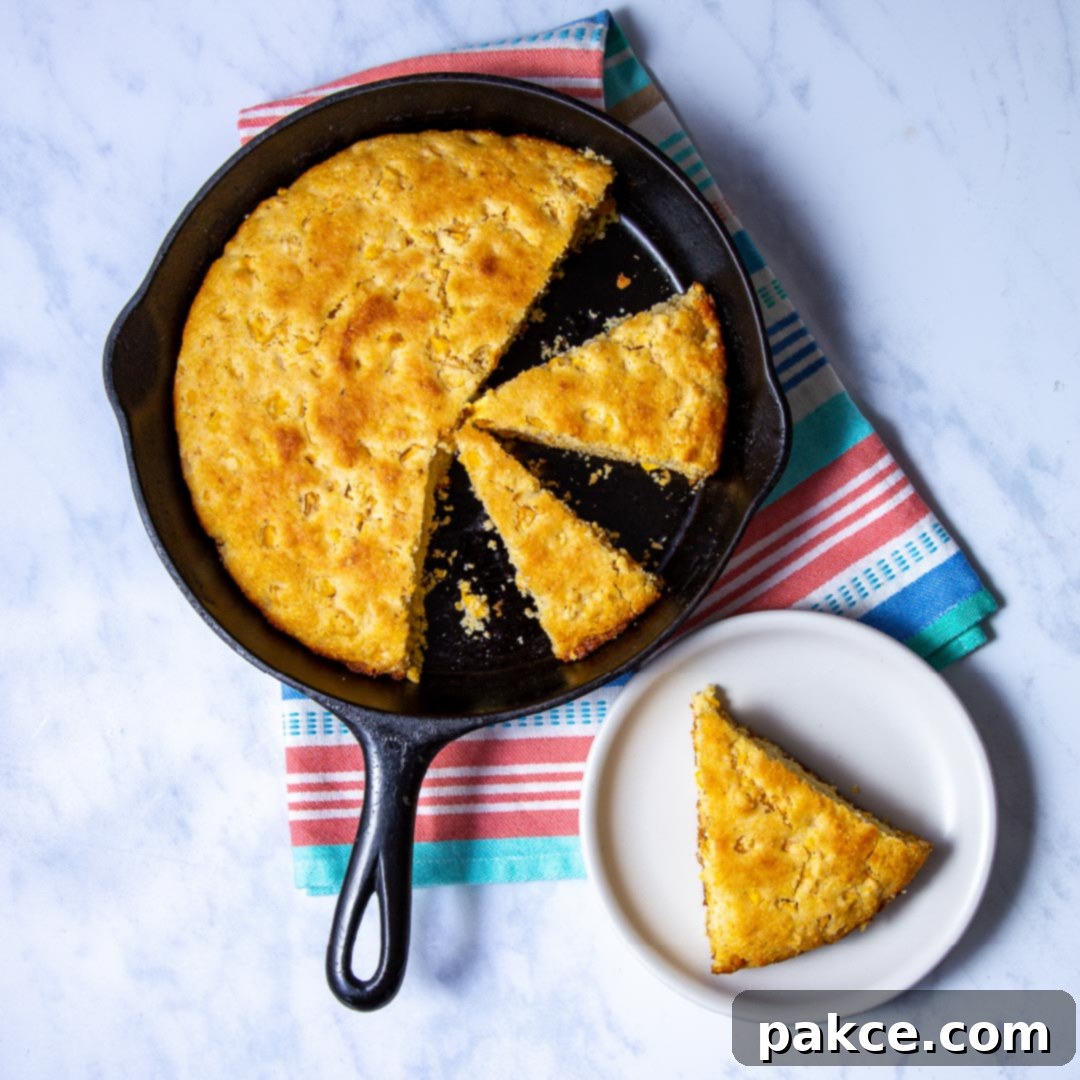Add Salt & Serve may earn affiliate commissions from purchases made using links on this page.
The Best Easy Cornbread with Sweet Corn Kernels: A Southern Comfort Staple
Prepare to delight your taste buds with this incredibly simple yet profoundly delicious recipe for homemade cornbread, generously studded with sweet corn kernels. This isn’t just any cornbread; it’s a golden-yellow marvel, boasting exquisitely browned, crispy edges that only a cast iron skillet can deliver, alongside a wonderfully moist and tender interior. Each bite is rich with the natural sweetness and satisfying texture of whole corn kernels, making it an utterly irresistible addition to any meal. Whether you’re looking for the quintessential side dish to complement a hearty spread, a flavorful foundation for robust pinto beans or chili, or simply a comforting treat to enjoy with a generous pat of butter, this cornbread is designed to impress and satisfy.
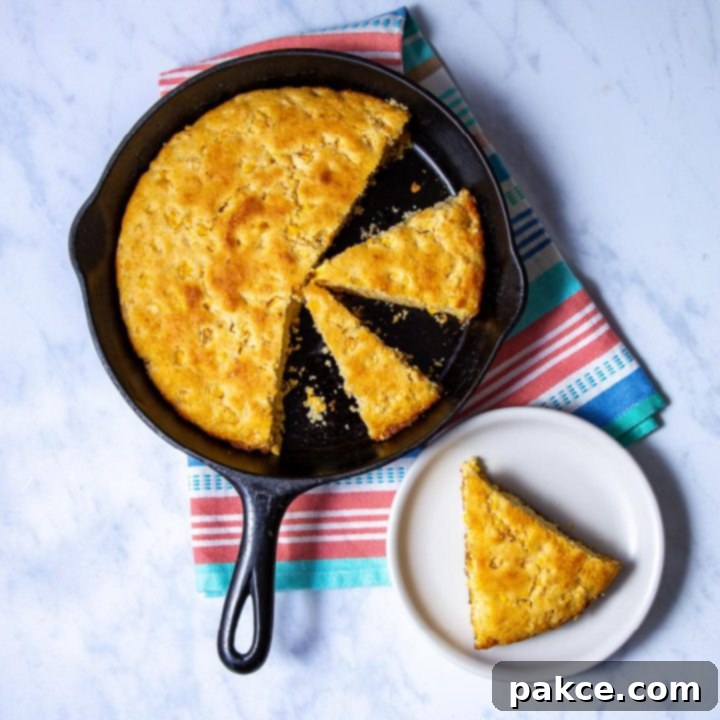
For me, there’s a profound sense of comfort and nostalgia in a classic Southern meal, and nothing quite hits the spot like a bowl of tender, perfectly seasoned pinto beans served over a warm, hearty slice of cornbread. This particular cornbread recipe, brimming with whole corn, is my absolute go-to for such an occasion. Imagine sinking your fork into a fluffy yet firm slice, then scooping up a generous helping of those earthy pinto beans, all crowned with the sharp bite of chopped onions and a sprinkle of melty shredded cheddar cheese. The inherent sweetness of the corn in this cornbread provides a delightful contrast to the savory beans, creating a harmonious symphony of flavors that is both deeply satisfying and soul-warming. It’s more than just a side; it’s an integral part of a cherished culinary tradition that can elevate any hearty dish.
Ingredients You’ll Need for Perfect Cornbread
Crafting this flavorful cornbread with its delightful corn kernels requires only a handful of readily available pantry staples. The beauty of this recipe lies in its simplicity, proving that you don’t need exotic ingredients to achieve an extraordinary result. Each component plays a vital role in creating the moist texture, golden hue, and irresistible taste of this classic side dish. Here’s a detailed look at what you’ll need to gather:
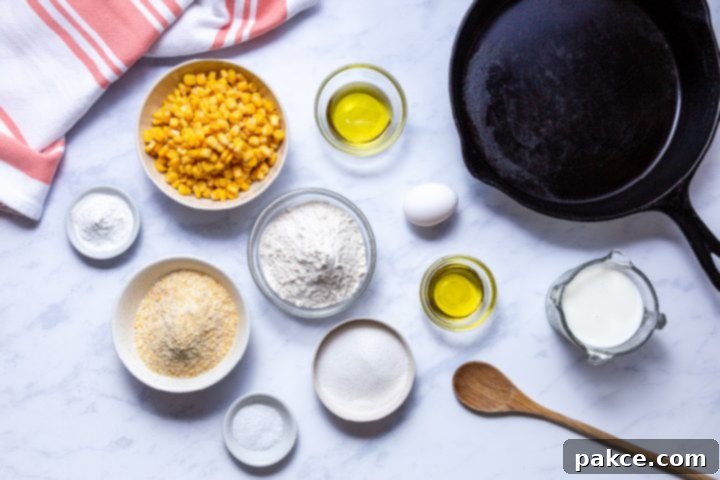
- Yellow Cornmeal (1 cup): The heart and soul of our cornbread! Yellow cornmeal imparts the characteristic texture and beautiful golden color. For a classic Southern texture, a medium-ground variety works wonderfully.
- All-Purpose Flour (1 cup): This provides essential structure to the cornbread, helping to bind the ingredients and ensuring a tender, less crumbly crumb than a purely cornmeal version.
- White Sugar (¼ cup): Just enough to enhance the natural sweetness of the corn kernels and balance the savory notes, giving us that popular ‘sweet cornbread’ profile. You can slightly adjust this amount based on your preference for a sweeter or more savory outcome.
- Baking Powder (3 teaspoons): Our primary leavening agent. Baking powder is crucial for giving the cornbread its light, airy rise and fluffy texture.
- Salt (1 teaspoon): A non-negotiable ingredient that amplifies all the other flavors, making the sweetness brighter and the corn taste more pronounced.
- Vegetable Oil (total 3 tablespoons): We use this in two ways. 1½ tablespoons are for preheating the cast iron skillet – this is the secret to achieving those coveted crispy, browned edges and preventing any sticking. The remaining 1½ tablespoons are incorporated directly into the batter to add moisture, richness, and contribute to the tender interior of the cornbread.
- Milk (1 cup): Provides the necessary liquid to bring the batter together, ensuring a moist and cohesive dough. Whole milk will yield a richer cornbread, but any milk will do. For a tangier flavor and an even more tender crumb, consider using buttermilk (see variations below).
- Large Egg (1): Acts as a crucial binder, holding all the ingredients together, and contributes to the overall structure and richness of the cornbread.
- Drained Canned Corn (15.25 ounces, approx. 1½ cups): The star addition! These sweet, tender kernels are dispersed throughout the cornbread, adding bursts of flavor and texture. It’s essential to drain them thoroughly to avoid making your batter too wet, which could result in a dense or soggy cornbread.
For your convenience and to ensure precise execution, a comprehensive recipe card with all quantities and detailed steps is available below.
Step-by-Step Instructions for Your Easy Cornbread
Making this cornbread recipe is not only simple but also incredibly rewarding. The key to achieving that perfect golden crust, moist interior, and ensuring your cornbread effortlessly releases from the pan lies in a few crucial steps, particularly the preparation of your cast iron skillet. Follow these detailed instructions to bake a flawless batch of cornbread every time:
Expert Hint for Achieving Crispy Edges: The fundamental secret to getting those highly desirable crispy, golden-brown edges on your cornbread and ensuring it slides out of the cast iron skillet with ease is to properly preheat the oil in the skillet before pouring in the batter. This creates an immediate sear on the bottom and sides, locking in moisture and developing that beautiful crust.
- Preheat Oven and Skillet: Start by preheating your oven to a robust 425ºF (220ºC). This high temperature is crucial for a good rise and quick crust formation. While the oven is warming up, pour exactly 1½ tablespoons of vegetable oil (this is half of your total oil) into your 9-inch cast iron skillet. Once the oven reaches the target temperature, carefully place the skillet containing the oil into the hot oven. Allow it to preheat for about 5-7 minutes. The oil should be visibly hot and shimmering, but never smoking or burning.
- Confirm Oil Readiness with a Simple Test: To be absolutely sure your preheating is complete, gently drop a tiny pinch of cornmeal or a minuscule amount of your mixed batter into the hot oil. If it immediately sizzles and bubbles, your skillet is perfectly ready for the batter. If not, give it another minute or two in the oven.
- Prepare the Cornbread Batter: While your skillet is getting to temperature, take a large mixing bowl and combine all the remaining ingredients: 1 cup yellow cornmeal, 1 cup all-purpose flour, ¼ cup white sugar, 3 teaspoons baking powder, 1 teaspoon salt, the remaining 1½ tablespoons of vegetable oil (for the batter), 1 cup milk, 1 large egg, and the thoroughly drained 15.25 ounces of canned corn. Stir these ingredients together until they are just combined and no dry pockets of flour are visible. Avoid the temptation to overmix, as this can develop the gluten in the flour and result in tough, dense cornbread. A few small lumps are perfectly normal and actually preferable!
- Pour Batter into the Sizzling Skillet: With extreme caution, using reliable oven mitts, remove the piping hot cast iron skillet from the oven. Immediately, and in one swift motion, pour the prepared cornbread batter into the center of the preheated skillet. You should hear a satisfying sizzle as the batter meets the hot oil – this is the sound of those perfect, crispy edges forming!
- Bake to Golden Perfection: Return the skillet to the preheated oven and bake for 20-25 minutes. Baking times can vary depending on your specific oven and the thickness of your cornbread. You’ll know your cornbread is perfectly done when the top is beautifully golden brown and a wooden toothpick or a thin knife inserted into the very center comes out clean. If there are moist crumbs clinging to the toothpick, that’s perfectly fine and indicates a wonderfully tender and moist interior, but wet batter means it needs more time.
- Cool and Serve: Once baked, carefully remove the skillet from the oven. Allow the cornbread to cool in the skillet for at least 5-10 minutes before attempting to slice it. This brief cooling period allows the cornbread to set properly, making it easier to cut into neat slices without crumbling. Serve it warm, perhaps with a touch more butter or honey, and enjoy your perfectly baked, easy cornbread!
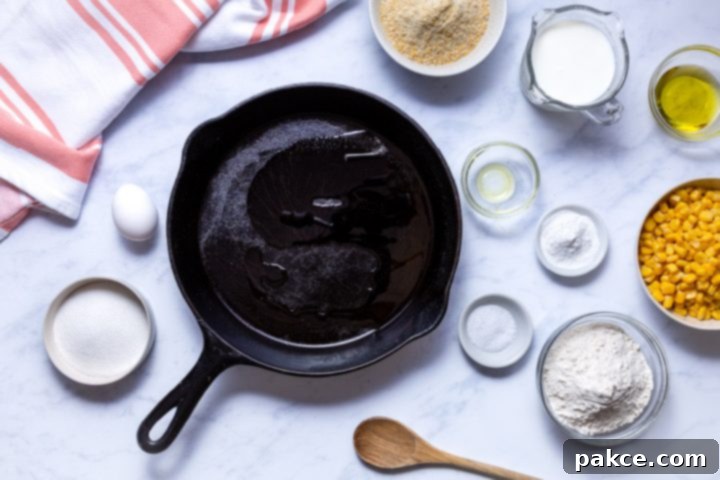
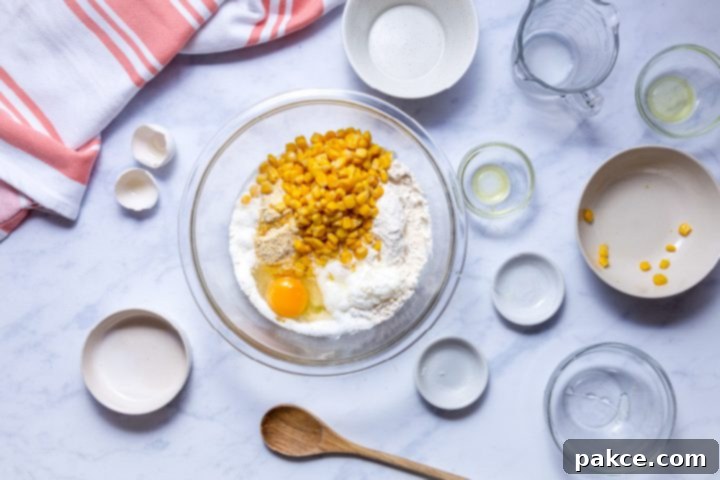
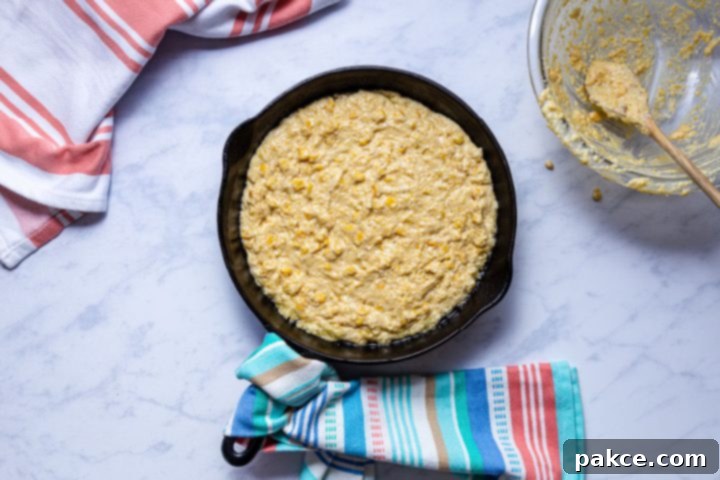
Delicious Serving Suggestions for Your Cornbread
This easy cornbread, bursting with sweet corn kernels, is far more versatile than just a simple side dish. Its unique blend of sweet and savory flavors, coupled with its moist yet firm texture, makes it an excellent companion to a wide array of meals. Don’t hesitate to think beyond the obvious and explore these fantastic ways to enjoy your freshly baked cornbread:
- The Classic Comfort: The simplest and often most beloved way to enjoy cornbread is warm, with a generous slather of butter. A drizzle of honey or maple syrup adds a delightful sweetness, creating a comforting snack or light breakfast.
- Hearty Stews and Soups: Cornbread is the ultimate accompaniment to robust dishes like beef stew, chicken and dumplings, or any creamy vegetable soup. Its absorbent nature makes it perfect for soaking up rich broths and gravies.
- Southern Dinner Staples: Naturally, this cornbread is a must-have alongside traditional Southern fare. Pair it with tender pinto beans, flavorful collard greens, crispy fried chicken, or even slow-cooked pork for an authentic meal.
- Chili’s Best Friend: A thick slice of this cornbread makes an ideal companion (or even a base) for a hearty bowl of chili. The mild sweetness beautifully balances the spice and richness of the chili.
- Breakfast Reinvented: Don’t let leftovers go to waste! Reheat slices in a toaster or oven and serve them with scrambled eggs, bacon, or sausage for a Southern-inspired breakfast that’s far from ordinary.
- Barbecue Essential: Elevate your barbecue spread by including this cornbread. It pairs wonderfully with smoked ribs, pulled pork, brisket, and all your favorite BBQ sides, cutting through the richness with its subtle sweetness.
- Savory Salad Croutons: For an unexpected twist, cube cooled cornbread, toss with a little olive oil and seasonings, then bake until crispy. These cornbread croutons add a delightful crunch and flavor to salads.
Customizable Substitutions and Variations for Your Cornbread
While the base recipe for this cornbread with sweet corn kernels is exceptional, it also serves as a fantastic canvas for culinary creativity. Don’t be afraid to experiment with these simple yet impactful substitutions and variations to tailor the recipe to your personal preferences, dietary needs, or simply to what you have available in your kitchen. Each modification can bring a unique character to your cornbread:
- Frozen Corn Option: If fresh or canned corn isn’t on hand, a cup of thawed and thoroughly drained frozen corn can be seamlessly substituted for the canned variety. The key here is proper thawing and draining to prevent adding excess moisture to your batter, which could affect the cornbread’s texture.
- Buttermilk for a Tangier Twist: For an even more tender crumb and a delightful tangy flavor, replace the regular milk with an equal amount of buttermilk. If you don’t have buttermilk, you can easily make your own: add one tablespoon of white vinegar or lemon juice to a liquid measuring cup, then fill the rest with regular milk (up to 1 cup mark) and let it sit for 5-10 minutes until it slightly curdles.
- Hoecakes (Johnny Cakes) Transformation: This versatile cornbread batter is perfectly suited for making individual hoecakes, also affectionately known as johnny cakes. These are akin to thick, savory pancakes made from cornmeal. To prepare, heat a lightly greased cast iron griddle or skillet over medium heat. Pour about ⅓ cup of batter per hoecake, cooking them like pancakes until bubbles appear on the surface and the edges are set. Carefully flip and cook until golden brown on the other side. They’re excellent with syrup or savory toppings.
- Cornbread Muffins or Sticks: For convenient, individual portions perfect for grab-and-go snacks or elegant serving, pour the batter into a greased cast iron muffin pan or a specialized corn stick pan. Adjust the baking time accordingly; muffins typically require 15-20 minutes in the 425ºF oven, or until a toothpick inserted into the center comes out clean.
- Sweetness Adjustment: If you prefer a richer, deeper flavor profile with a hint of molasses, consider substituting half or all of the white sugar with an equal amount of light or dark brown sugar. This can add an extra layer of complexity to your sweet cornbread.
- Gluten-Free Flour Blend: For those with gluten sensitivities, a 1:1 gluten-free all-purpose flour blend can often be substituted for the regular flour. Always check the specific blend’s recommendations, as some may require slight adjustments to liquid content.
Creative Cornbread Add-ins for Enhanced Flavor
While the classic cornbread with sweet corn kernels is fantastic on its own, it also acts as a superb foundation for a myriad of flavor enhancements. By incorporating a few extra ingredients, you can transform your cornbread into a more complex and exciting dish, perfectly suited for different palates and meal pairings. Here are some inspiring ideas to elevate your cornbread:
- Jalapeño and Cheddar (Mexican Cornbread): For a delightful spicy and cheesy kick, fold in approximately ¼ to ½ cup of finely chopped, fresh or pickled jalapeños (ensure fresh ones are deseeded for less heat) and ½ to 1 cup of shredded sharp cheddar cheese into your batter. This combination creates a savory “Mexican cornbread” that’s truly exceptional with tacos, enchiladas, or as a standalone snack. The sharp cheddar perfectly complements the mild spice of the jalapeños.
- Diced Green Chilies: If you’re looking for a milder, earthy heat and a subtle smoky note, stir in one small can (around 4 ounces) of thoroughly drained diced green chilies. These provide a gentle warmth and a lovely depth of flavor without overpowering the cornbread, making it a great addition to Tex-Mex inspired meals.
- Chopped Green Onions: For a fresh, delicate oniony flavor and a touch of vibrant color, gently fold in about 2-3 chopped green onions (scallions) into your batter. They add a mild, herbaceous bite that enhances the savory aspects of the cornbread, pairing particularly well with rich, meaty main courses.
- Crispy Bacon Bits: For an irresistible smoky, salty, and utterly savory crunch, mix in about ½ cup of cooked and crumbled bacon bits. The bacon fat renders into the cornbread during baking, infusing it with incredible flavor, while the crispy bits add a delightful textural contrast.
- Creamed Corn for Extra Moisture: For an exceptionally moist and slightly sweeter cornbread, consider replacing a portion of the drained canned corn with an equal amount of creamed corn, or add a small amount of creamed corn in addition to the kernels. This will result in a denser, richer, and incredibly tender cornbread.
- Sweet Corn and Chive: A simple yet elegant addition is to incorporate a handful of fresh, finely chopped chives. Their delicate oniony flavor pairs wonderfully with the sweet corn, adding freshness without the pungency of stronger onions.
- Roasted Red Peppers: For a sweet and smoky flavor profile, chop and drain a jar of roasted red peppers and fold them into the batter. They add a beautiful color and a depth of flavor that complements the corn.
Mastering Cast Iron Care and Storage
Using a cast iron skillet is truly the secret weapon for baking exceptional cornbread, as it’s unparalleled in its ability to create that signature crispy, golden-brown crust. Proper care of your cast iron isn’t just about maintenance; it’s about preserving a culinary tool that, with the right attention, can last for generations and develop a naturally non-stick surface that improves with every use.
Interesting Historical Note: You might observe that vintage, well-loved cast iron pans often possess a remarkably smoother cooking surface compared to their modern counterparts. This isn’t merely a coincidence; historically, cast iron pans were typically sold unseasoned, requiring home cooks to build up their own layers of seasoning through diligent use and care. The slightly pebbly or textured finish commonly found on newer cast iron pans is a result of advancements in manufacturing processes that allow manufacturers to pre-season the pans before they reach consumers. While both types are excellent for cooking, older, smoother pans are often cherished for their unique patina and the stories of countless meals cooked within them.
For this delicious cornbread recipe and many other culinary adventures, a Preseasoned 9″ Cast Iron Skillet offers excellent heat retention and a dependable cooking surface, ensuring consistently great results.
Cleaning Your Cast Iron: Separating Fact from Fiction
One of the most enduring myths about cast iron care is that you should never, ever wash it with soap. Let’s debunk that myth! A properly seasoned cast iron pan is coated with a layer of polymerized oil—essentially, oil that has been chemically bonded to the metal through heat. This layer is robust and durable, meaning modern dish soaps (surfactants) will not strip away your hard-earned seasoning. Feel free to use a small amount of mild dish soap and a sponge to clean your pan after cooking. This same principle applies to using metal utensils; they won’t scrape off a truly polymerized seasoning layer.
However, while soap is fine, cast iron is still iron and highly susceptible to rust. To prevent this, always avoid soaking your cast iron pan in water for prolonged periods. The moment you finish washing it, dry it immediately and thoroughly. A great best practice is to place the clean, dry pan back on a low burner for a few minutes until any residual moisture has completely evaporated. Dishwashers are an absolute no-go for cast iron; the extended exposure to hot water and harsh detergents will quickly strip the seasoning and almost certainly lead to rust. With a little care, your cast iron skillet will be a reliable kitchen companion for years to come.
Proper Storage for Fresh Cornbread
Once your delectable cornbread has cooled, proper storage is essential to maintain its freshness, moisture, and delightful flavor. Here’s how to keep it at its best:
- Room Temperature: For short-term enjoyment, your cornbread can be stored at room temperature in an airtight container. This method typically keeps it fresh for up to three days. However, this duration can vary based on your local environment’s heat and humidity levels. In warmer, more humid climates, it might not last quite as long.
- Refrigeration for Extended Freshness: If you live in a particularly hot or humid area, or simply wish to extend the shelf life of your cornbread, refrigeration is a good option. Place it in an airtight container or wrap it tightly in plastic wrap before storing it in the fridge. Here, it can remain fresh for approximately one week.
- Freezing for Long-Term Preservation: Cornbread freezes exceptionally well, making it perfect for meal prep or saving leftovers. To freeze, wrap individual slices or the entire loaf tightly in plastic wrap, then place it into a freezer-safe bag or an airtight container. Properly packaged, cornbread can be stored in the freezer for up to three months. When you’re ready to enjoy it, simply thaw at room temperature or gently reheat slices in the oven or microwave for a quick and comforting treat.
Frequently Asked Questions About Cornbread
Even though this recipe is designed to be easy, you might still have some questions about making the perfect cornbread. Here are answers to common inquiries to help ensure your baking journey is smooth and successful:
- Q: Why is my cornbread dry and crumbly?
A: Dry and crumbly cornbread is often a result of over-baking or an imbalance of wet and dry ingredients. Ensure you measure your ingredients accurately. Overmixing the batter can also develop gluten, leading to a tougher, drier texture. Always aim to mix just until combined. When checking for doneness, look for a toothpick that comes out clean but with moist crumbs still clinging, not completely dry. - Q: Can I use fresh corn instead of canned or frozen?
A: Absolutely! Fresh corn kernels are a fantastic addition. You’ll need about 1½ cups of kernels, typically from 2-3 ears of corn. If using fresh, you might want to briefly sauté them in a little butter for a few minutes before adding them to the batter; this enhances their natural sweetness and ensures they are tender in the baked cornbread, though it’s not strictly necessary. - Q: What’s the main difference between Northern and Southern cornbread?
A: Traditionally, Northern cornbread often incorporates more sugar and flour, resulting in a sweeter, cake-like texture. Southern cornbread, on the other hand, typically uses less sugar (sometimes none) and a higher ratio of cornmeal, leading to a more savory, robust, and sometimes crumbly texture. This recipe aims for a delicious balance, offering a hint of sweetness that appeals to many. - Q: My cornbread stuck to the cast iron skillet, what went wrong?
A: Sticking in a cast iron skillet usually indicates that the skillet and the oil were not sufficiently preheated. The high heat of the oil creates a non-stick barrier that helps the cornbread release. Always ensure your skillet is shimmering hot before pouring in the batter. Also, regularly seasoning your cast iron pan helps build a natural non-stick surface over time. - Q: Can I make this recipe in a pan other than cast iron?
A: Yes, you certainly can. A 9×9-inch square baking dish or an 8-inch round cake pan will work. However, you won’t achieve the same intensely crispy and beautifully browned edges that are characteristic of baking in a hot cast iron skillet. Regardless of the pan type, ensure it’s thoroughly greased and, if not cast iron, lightly floured to prevent sticking. You might need to adjust the baking time slightly. - Q: How do I make my cornbread sweeter or more savory?
A: To make it sweeter, you can increase the sugar by an extra tablespoon or two, or drizzle honey/maple syrup over the top after baking. For a more savory profile, slightly reduce the sugar (or omit it entirely if preferred) and consider adding savory elements like cheese, jalapeños, or green onions (as suggested in the “Add-ins” section).
Recipe Card: Easy Cornbread with Sweet Corn Kernels
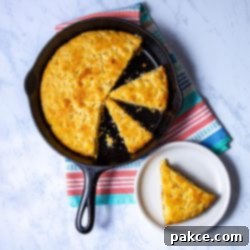
Easy Cornbread with Canned Corn
Mary Ann
Add to Shopping List
10 minutes
25 minutes
35 minutes
Bread, Side Dish
American, Southern
8 slices
286
Equipment
-
9″ Cast Iron Skillet
-
Large Mixing Bowl
-
Whisk or Spoon
-
Oven Mitts
Ingredients
- 1 cup yellow cornmeal
- 1 cup all-purpose flour
- ¼ cup sugar
- 3 teaspoons baking powder
- 1 teaspoon salt
- 1½ tablespoons vegetable oil, for preheating pan
- 1½ tablespoons vegetable oil, for batter
- 1 cup milk
- 1 large egg
- 15.25 ounces canned corn, drained
Instructions
-
Preheat oven to 425°F (220°C).
-
Put 1½ tablespoons vegetable oil in a 9x9x2 cast iron skillet and place it in the preheated oven for 5-7 minutes until the oil is hot and shimmering (do not let it burn or smoke). Tip: Test oil readiness by dropping a tiny bit of cornmeal or batter into it; if it sizzles, it’s ready.
-
While the oil is heating, mix 1 cup yellow cornmeal, 1 cup all-purpose flour, ¼ cup sugar, 3 teaspoons baking powder, 1 teaspoon salt, 1½ tablespoons vegetable oil (for batter), 1 cup milk, 1 large egg, and 15.25 ounces drained canned corn in a large bowl. Stir until just combined; do not overmix.
-
Carefully remove the preheated cast iron skillet from the oven using oven mitts.
-
Pour the cornbread batter immediately into the hot skillet. Bake for 20-25 minutes, or until the top is golden brown and a toothpick inserted into the middle comes out clean (moist crumbs are acceptable).
-
Remove from oven and let cool slightly in the skillet before slicing and serving warm.
Notes
Nutrition per serving
Calories: 286 cal
Carbohydrates: 42 g
Protein: 6 g
Fat: 10 g
Sodium: 402 mg
Fiber: 2 g
Sugar: 8 g
Net Carbohydrates: 40 g
Share on Facebook
Pin Recipe
We sincerely hope you enjoy preparing and savoring this easy and incredibly flavorful cornbread recipe. It’s a timeless classic that effortlessly brings warmth, comfort, and deliciousness to any table. May your kitchen be filled with its inviting aroma and your meals with its delightful taste. Happy baking!
